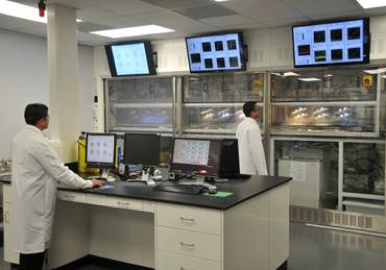
The oil industry has a host of methods for keeping hydrocarbons moving smoothly through flowlines, depending on what might restrict production.
Hydrates, or ice-like solids resulting from the combination of free water and natural gas at high pressure and low temperature, can plug a pipeline, and low-dosage hydrate inhibitors (LDHIs) are one of the chief defenses against this problem. LDHIs come in two chief varieties, kinetic hydrate inhibitors (KHIs) and anti-agglomerants (AAs), which are suitable for different situations.
Loan Vo, R&D advisor with Multi-Chem, Halliburton’s specialty chemicals business, says kinetic inhibitors are effective, but because of the way they work require a good understanding of how long to delay the formation of the hydrate. This is not always known, she says, and could ultimately put a pipeline at risk, particularly if a platform had to be shut down ahead of a hurricane and remains shut down for a week or two.
“KHIs typically aren’t going to prevent hydrate formation for that period of time,” says Sean Daly, manager for deepwater and flow assurance engineering for Multi-Chem, a Halliburton service.
Vo elaborates, “Anti-agglomerants don’t prevent hydrates from forming, but they prevent it from sticking together to create a big mass.”
AAs are surfactants, and different production streams require different AA chemistries because the reservoir fluid composition – ranging from light to heavy oil along with impurities like paraffins and asphaltenes – will play a big part in how hydrates form, she says.
“It takes a very specific head structure with the right organic functional groups for the surfactant molecules to orient and align themselves correctly on the hydrate particle surface to prevent hydrate particles from agglomerating together into larger masses. The functionality and length of the hydrophobic tail is pivotal in how quickly the surfactant gets to the oil/water interface and has a huge impact on AA performance in oils with different characteristics,” says Vo.
While one AA that can treat all production streams is “the holy grail of LDHIs,” a number of factors make that difficult, Daly says. “It depends on different oil types, salinity, water cuts, and several other factors.”
Multi-Chem embarked on an R&D project to fill in the gaps in its AA portfolio and has developed three new products to meet oilfield needs, and a fourth is under development, Daly says.
Development entailed tailoring the head and the tail chemistries to flesh out the AA portfolio, which now covers 90% of the market need, Vo says. One of the additions is readily biodegradable, she adds.
“We are scaling up and getting ready for commercialization,” she says.



